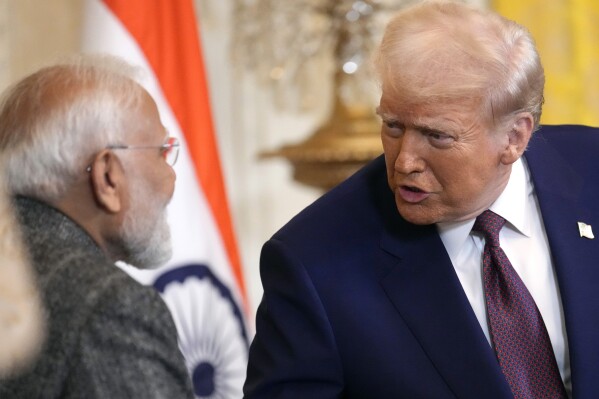Trump-Modi Relations: Strategic Fluctuations (2025)
Navigating Trade, Defense, Energy, and Diplomacy Amid Global Rivalries
Introduction
In 2025, the U.S.-India relationship under President Donald Trump and Prime Minister Narendra Modi blends personal warmth with policy friction. Trump’s 50% tariffs on Indian imports, driven by India’s Russian oil purchases, have strained ties, while Modi’s assertive pushback and outreach to China and Russia signal strategic autonomy. Despite this, defense cooperation and diplomatic optimism persist. This webpage analyzes key areas—trade, tariffs, defense, energy, and diplomacy—along with implications and the outlook as of September 2025.[web:0][web:4]
Key Areas of Discussion
Trade Relations
Trump’s administration imposed 50% tariffs on Indian imports, effective August 27, 2025, targeting $37 billion in exports, particularly textiles and gems, due to India’s Russian oil purchases. Modi has resisted, prioritizing protection for India’s farmers, a key voting bloc, and domestic industries.[web:1][web:3]
Tariffs and Trade Agreements
Despite tensions, Trump remains optimistic, promising “wonderful trade deals” and noting India’s offer of a “zero-for-zero” tariff deal on steel and pharmaceuticals in May 2025, which failed to materialize. Trade talks continue, with India seeking to maintain agricultural protections.[web:5][web:16]
Defense Collaboration
The U.S. and India launched a joint military exercise in Alaska in 2025, reinforcing cooperation against China’s Indo-Pacific influence. Defense ties remain a cornerstone, with India diversifying arms sources but maintaining U.S. partnerships.[web:4]
Energy Cooperation
Trump criticized India’s 36–40% reliance on Russian oil (1.6–2 million b/d), arguing it fuels Russia’s war in Ukraine. Modi defends these purchases as essential for India’s 1.4 billion citizens, noting U.S. encouragement during the Biden era to stabilize global oil prices.[web:2][web:10]
Diplomatic Relations
Personal Rapport
Trump frequently praises Modi as a “great leader” and “tough negotiator,” humorously admitting Modi outshines him in negotiations. Their early 2025 meetings set ambitious trade goals ($500 billion by 2030).[web:4][web:5]
Strained Relations
Tariffs and Russia ties have caused friction. Modi’s reported refusal of four Trump calls and his planned visits to China and Russia signal defiance. Yet, Trump insists, “I’ll always be friends with Modi.”[post:5][web:6]
Recent Developments
Modi’s assertiveness is evident in his resistance to tariffs and plans to attend the SCO summit in China (August 31–September 1, 2025) and meet Putin. India emphasizes a “Comprehensive and Global Strategic Partnership” with the U.S., balancing autonomy with cooperation. Trump’s claim of brokering an India-Pakistan ceasefire, denied by Modi, adds tension.[web:6][web:15][post:0]
Implications
- Trade Friction: Persistent tariffs risk pushing India toward China and Russia, reducing U.S. economic leverage.[web:1]
- Defense Stability: Joint exercises ensure security ties endure, countering China’s regional influence.[web:4]
- Energy Tensions: India’s Russian oil imports limit Trump’s ability to isolate Moscow, as halting them could spike global oil prices to $200/b.[web:1]
- Diplomatic Hedging: Modi’s outreach to Xi and Putin reflects India’s strategic autonomy, challenging U.S. expectations of alignment.[web:6]
Outlook
Short-Term: Defense and counterterrorism cooperation will continue, but trade talks will remain contentious.
Medium-Term: India’s engagement with Russia and China may dilute U.S. influence unless Trump offers economic concessions.
Long-Term: The partnership’s success depends on mutual acceptance of strategic priorities—India’s autonomy and U.S. need for a reliable Indo-Pacific partner.[web:10][web:6]
Conclusion
Trump and Modi’s relationship in 2025 combines personal warmth with policy friction over tariffs and Russian oil. Defense ties and joint exercises provide stability, but India’s strategic autonomy—evident in Modi’s outreach to China and Russia—challenges U.S. leverage. Balancing trade disputes with security cooperation will shape this “special” yet fragile partnership. Monitor U.S. State Department (https://www.state.gov) and India’s Ministry of External Affairs (https://www.mea.gov.in) for updates.[web:0][web:4]
Sources
- Trump Raises Tariffs on India to 50% Over Russian Oil, NYT
- India’s Russian Oil Gains Wiped Out by Tariffs, Reuters
- Trump Raises India Tariffs to 50%, CNBC
- Trump Imposes 50% Tariff on India, The Guardian
- Trump-Modi Ties Hit Rock Bottom, BBC
- Trump Calls India-US Trade One-Sided, CNBC
- Modi and Putin Affirm Ties, NPR
- India Calls Out US and EU, CNBC
- Trump Wields India-Russia Trade Against Modi, Washington Post
- Trump Threatens India with 50% Tariffs, CNN
- Modi Caught Between Putin and Trump, CNN
- Trump Slaps 50% Tariff on India, Al Jazeera
- Trump Threatens India with Tariffs, NYT
- Trump Threatens 50% Tariffs on India, BBC
- Trump Threatens Tariff Hikes on India, Reuters
- India’s Russian Oil Imports Rise, Times of India
- Navarro Calls Russia-Ukraine Modi’s War, BBC
- Trump Warns India After SCO Summit, Newsweek
- Modi Ready to Make India Great, NBC
- Trump Tariffs on India Over Russia and BRICS, The Guardian
- Trump Doubles India Tariffs to 50%, Bloomberg
- X Post by @MyLordBebo, August 27, 2025
- X Post by @BohuslavskaKate, August 31, 2025
